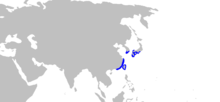Japanese sleeper ray
| Japanese sleeper ray | |
|---|---|

| |
| Scientific classification | |
| Domain: | Eukaryota |
| Kingdom: | Animalia |
| Phylum: | Chordata |
| Class: | Chondrichthyes |
| Subclass: | Elasmobranchii |
| Superorder: | Batoidea |
| Order: | Torpediniformes |
| Family: | Narkidae |
| Genus: | Narke |
| Species: | N. japonica
|
| Binomial name | |
| Narke japonica | |

| |
| Geographic range[1] | |
| Synonyms | |
|
Torpedo japonica Temminck & Schlegel, 1850 | |
The Japanese sleeper ray (Narke japonica) is a
caudal fin
.
Inhabiting shallow, sandy areas near rocky reefs, the Japanese sleeper ray is a
fisheries
that operate intensively throughout its range.
Taxonomy
The first specimens of the Japanese sleeper ray known to science were four fish collected from Japan by German
conspecific with the Japanese sleeper ray, as their morphology is virtually identical.[6]
Description

The Japanese sleeper ray has an almost circular
tooth rows in each jaw, arranged into bands; the teeth are small with oval bases and pointed crowns. Five pairs of short gill slits are located on the underside of the disc.[4][7]
The
dermal denticles. The Japanese sleeper ray is reddish to chocolate brown above and paler brown below; some individuals are plain, while others have dark or light spots over their dorsal (rarely also ventral) surfaces. The maximum known length of this species is 40 cm (16 in).[4][7][8]
Distribution and habitat
The Japanese sleeper ray inhabits
bottom-dwelling species can be found in sandy areas, often near rocky reefs, both close to and far from shore. Off the Izu Peninsula, it has been reported from 12–23 m (39–75 ft) in depth.[8]
Biology and ecology


Fairly inactive in nature, the Japanese sleeper ray spends much of its time lying buried on the
The Japanese sleeper ray is
histotroph ("uterine milk") produced by the mother. Females bear litters of up to five pups in early summer; the newborns measure 10 cm (3.9 in) long and are lighter and more uniform in color than the adults.[7][8] Sexual maturity is reached at a length between 23–37 cm (9.1–14.6 in) for males, and at around 35 cm (14 in) for females.[4]
Human interactions
The shock from the Japanese sleeper ray is strong but not life-threatening to humans.
Though little specific data are available, the Japanese sleeper ray is believed to be
trawls and other demersal fishing gear throughout its range. It is not utilized economically; however, electric rays tend not to survive being caught and discarded, and shrimp trawling is known to have caused marked population declines in other electric ray species elsewhere. Given the high intensity of fishing activity off East Asia, the International Union for Conservation of Nature (IUCN) has assessed this species as Vulnerable.[1]
References
- ^ . Retrieved 20 November 2021.
- ^ a b Boeseman, M. (1947). "Revision of the fishes collected by Burger and Von Siebold in Japan". Zoologische Mededelingen. 28: 1–242.
- ^ Temminck, C.J.; Schlegel, H. (1850). Fauna Japonica, sive descriptio animalium quae in itinere per Japoniam suscepto annis 1823–30 collegit, notis observationibus et adumbrationibus illustravit P. F. de Siebold (Pisces). Regis Auspiciis Editce. p. 307.
- ^ ISBN 92-5-104302-7.
- ^ a b Froese, R.; Pauly, D., eds. (2011). "Narke japonica, Japanese sleeper ray". FishBase. Retrieved May 31, 2013.
- ^ Compagno, L.J.V.; Heemstra, P.C. (2007). "Electrolux addisoni, a new genus and species of electric ray from the east coast of South Africa (Rajiformes: Torpedinoidei: Narkidae), with a review of torpedinoid taxonomy". Smithiana Bulletin. 7: 15–49.
- ^ .
- ^ ISBN 0-930118-18-9.
- S2CID 30998546.
- ^ Yamaguti, S. (1934). "Studies on the Helminth fauna of Japan. Part 4. Cestodes of fishes". Japanese Journal of Zoology. 6: 1–112.
- ^ Subhapradha (1955). "Cestode parasites of fishes of Madras Coast". Indian Journal of Helminthology. 7 (2): 41–132.
- S2CID 22342105.

